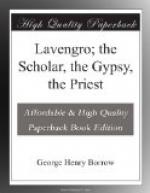And when I had passed through the Cheape I entered another street, which led up a kind of ascent, and which proved to be the street of the Lombards, called so from the name of its first founders; and I walked rapidly up the street of the Lombards, neither looking to the right nor left, for it had no interest for me, though I had a kind of consciousness that mighty things were being transacted behind its walls: but it wanted the throng, bustle, and outward magnificence of the Cheape, and it had never been spoken of by ‘ruddy bards’! And, when I had got to the end of the street of the Lombards, I stood still for some time, deliberating within myself whether I should turn to the right or the left, or go straight forward, and at last I turned to the right, down a street of rapid descent, and presently found myself upon a bridge which traversed the river which runs by the big city.
A strange kind of bridge it was; huge and massive, and seemingly of great antiquity. It had an arched back, like that of a hog, a high balustrade, and at either side, at intervals, were stone bowers bulking over the river, but open on the other side, and furnished with a semicircular bench. Though the bridge was wide—very wide—it was all too narrow for the concourse upon it. Thousands of human beings were pouring over the bridge. But what chiefly struck my attention was a double row of carts and wagons, the generality drawn by horses as large as elephants, each row striving hard in a different direction, and not unfrequently brought to a stand-still. Oh the cracking of whips, the shouts and oaths of the carters, and the grating of wheels upon the enormous stones that formed the pavement! In fact, there was a wild burly-burly upon the bridge, which nearly deafened me. But, if upon the bridge there was a confusion, below it there was a confusion ten times confounded. The tide, which was fast ebbing, obstructed by the immense piers of the old bridge, poured beneath the arches with a fall of several feet, forming in the river below as many whirlpools as there were arches. Truly tremendous was the roar of the descending waters, and the bellow of the tremendous gulfs, which swallowed them for a time, and then cast them forth, foaming and frothing from their horrid wombs. Slowly advancing along the bridge, I came to the highest point, and there I stood still, close beside one of the stone bowers, in which, beside a fruit-stall, sat an old woman, with a pan of charcoal at her feet, and a book in her hand, in which she appeared to be reading intently. There I stood, just above the principal arch, looking through the balustrade at the scene that presented itself—and such a scene! Towards the left bank of the river, a forest of masts, thick and close, as far as the eye could reach; spacious wharfs, surmounted with gigantic edifices; and, far away, Caesar’s Castle, with its White Tower. To the right, another forest of masts, and a maze of buildings, from which, here




